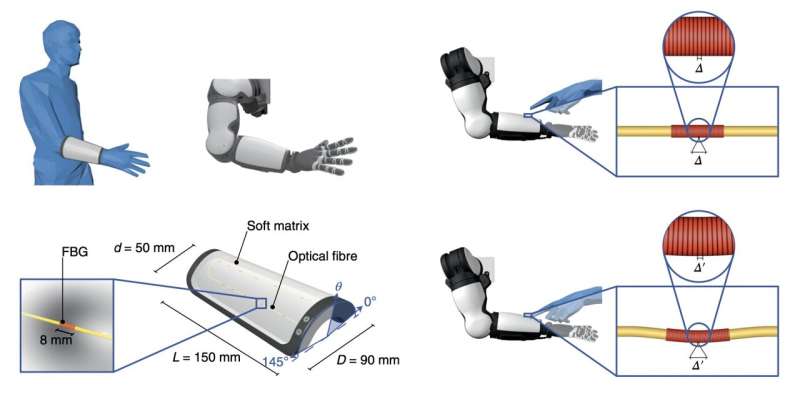June 30, 2022 feature
Mimicking the function of Ruffini receptors using a bio-inspired artificial skin

Mobile robots are now being introduced into a wide variety of real-world settings, including public spaces, home environments, health care facilities and offices. Many of these robots are specifically designed to interact and collaborate with humans, helping them to complete hands-on physical tasks.
To improve the performance of mobile robots on interactive and manual tasks, roboticists will need to ensure that they can effectively sense stimuli in their environment. In recent years, many engineers and material scientists have thus been trying to develop systems that can artificially replicate biological sensory processes.
Researchers at Scuola Superiore Sant'Anna, Ca' Foscari University of Venice, Sapienza University of Rome and other institutes in Italy have recently used an artificial skin and a deep learning technique that could be used to improve the tactile capabilities of both existing and newly developed robots to replicate the function of the so-called Ruffini receptors. Their approach, introduced in a paper published in Nature Machine Intelligence, replicates the function of a class of cells located on the human superficial dermis (i.e., subcutaneous skin tissue), known as Ruffini receptors.
Ruffini receptors, also known as Ruffini endings or corpuscles, are small and slowly adapting cells that can detect the stretching of the skin, as well as low-frequency vibrations, warmth and pressure. They are one of the four primary types of skin receptors, along with Merkel cells, Pacinian corpuscles and Meissner corpuscles.
To replicate the function of Ruffini endings, the researchers used a soft, curved and large-area artificial skin, comprising an 8mm-thick stretchable polymeric layer, with a 430mm-long optical fiber integrated in it. The artificial skin was created using 3D printing technology.
"The biomimetic skin consists of a soft polymeric matrix, resembling a human forearm, embedded with photonic fiber Bragg grating transducers, which partially mimics Ruffini mechanoreceptor functionality with diffuse, overlapping receptive fields," Luca Massari and his colleagues explained in their paper.
To process and make sense of the signals picked up by the artificial skin they created, the researchers developed a deep learning model based on a multi-layered convolutional neural network (CNN). This algorithm was trained to estimate the force applied to the artificial skin's surface and estimate the points where the robot is touching something.
"A CNN-based deep learning algorithm and a multigrid neuron integration process were implemented to decode the fiber Bragg grating sensor outputs for inference of contact force magnitude and localization through the skin surface," the researchers wrote in their paper.
The researchers evaluated their artificial skin-based system in a series of simulations and tests. They found that it achieved very promising results, effectively predicting the force applied to the artificial skin and the location where it was applied.
"Results of 35 mN (interquartile range 56 mN) and 3.2 mm (interquartile range 2.3 mm) median errors were achieved for force and localization predictions, respectively," the researchers wrote. "Demonstrations with an anthropomorphic arm pave the way towards artificial intelligence based integrated skins enabling safe human-robot cooperation via machine intelligence."
In the future, the system created by this team of researchers could be implemented on a variety of humanoid robots, as the modular patches that make up the skin should theoretically fit different architectures and shapes. Therefore, in their next studies, Massari and his colleagues plan to test the extent to which their approach can be applied to other systems.
More information: Luca Massari et al, Functional mimicry of Ruffini receptors with fibre Bragg gratings and deep neural networks enables a bio-inspired large-area tactile-sensitive skin, Nature Machine Intelligence (2022). DOI: 10.1038/s42256-022-00487-3
© 2022 Science X Network

















